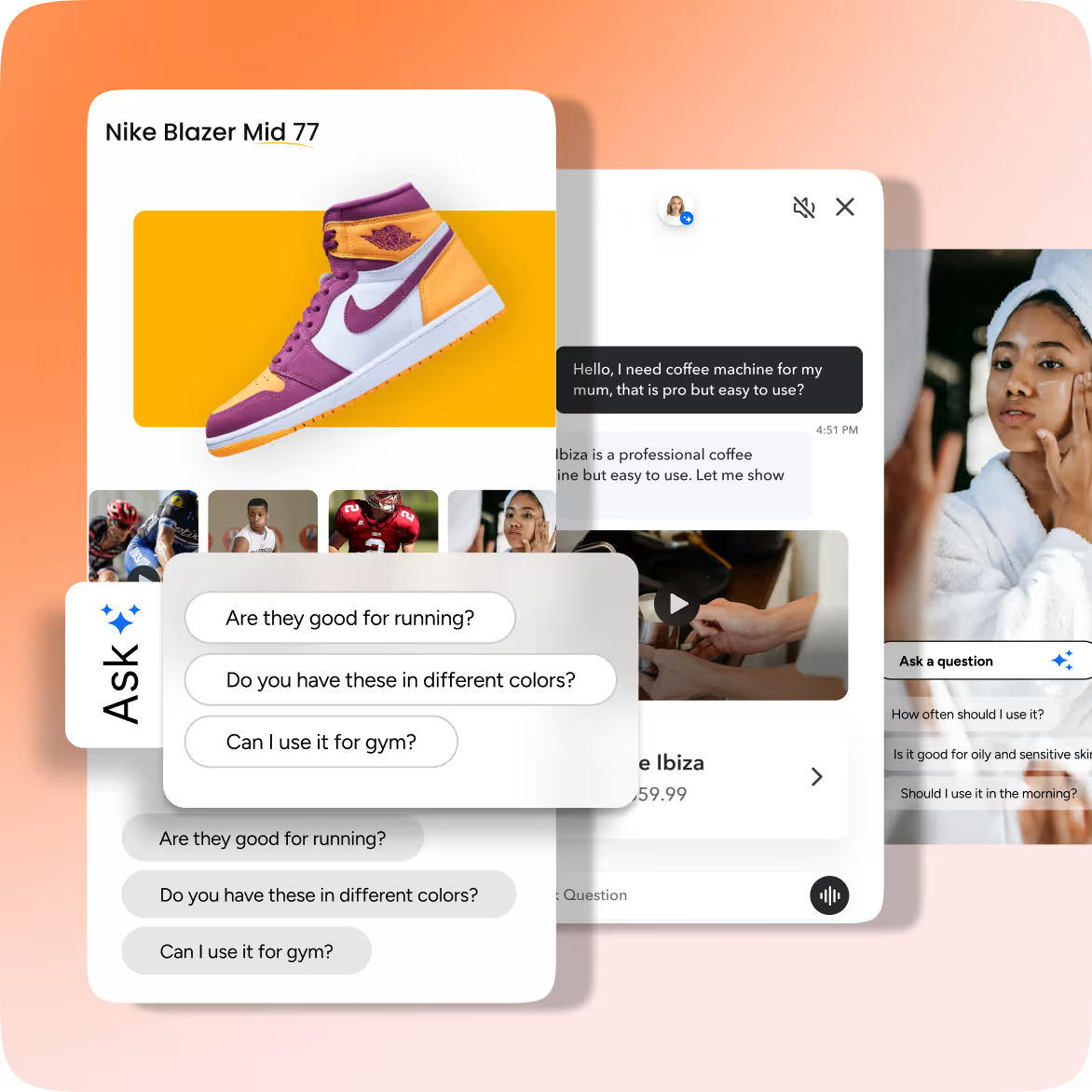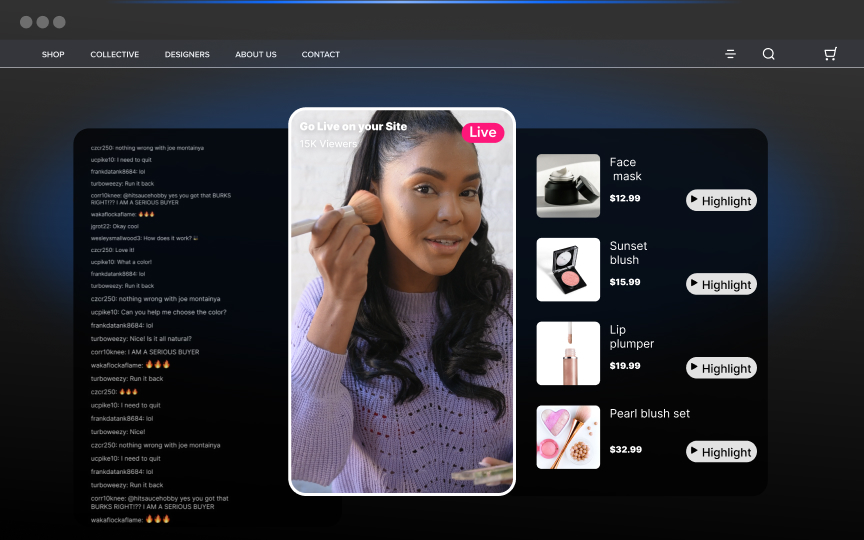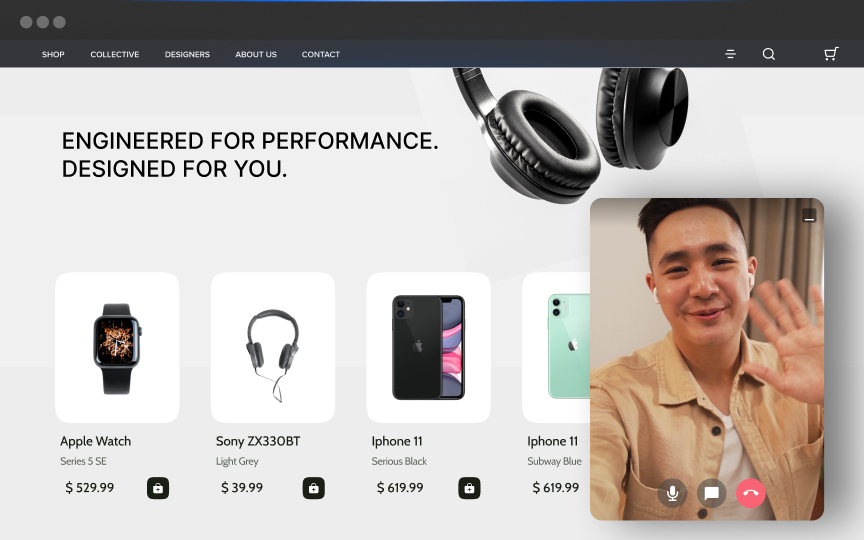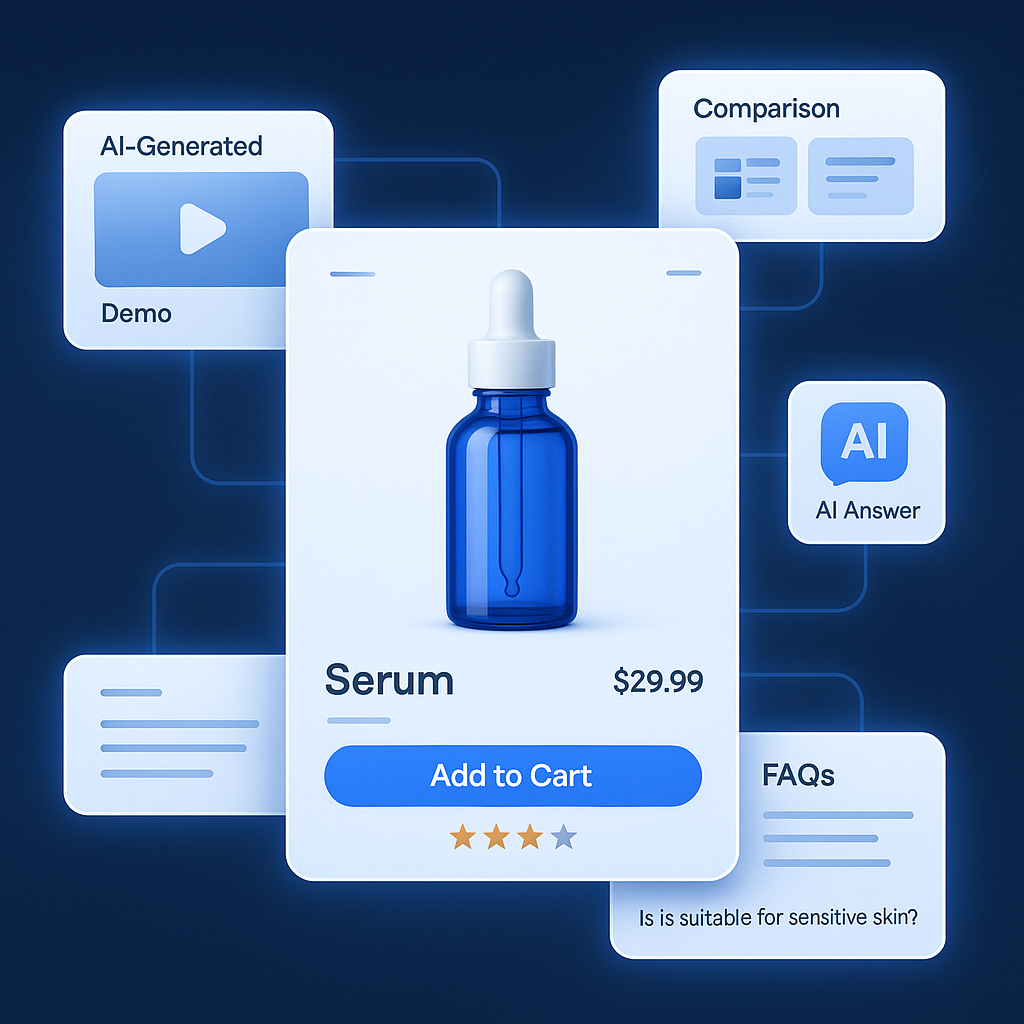Ever noticed how content that speaks directly to you just feels different? That's exactly how personalized video transforms customer experience.
The personalized video weaves individual data—like names, preferences, or past interactions—into custom content tailored for each viewer. This approach doesn't just get viewers to watch; it resonates on a personal level, strengthening trust and engagement with every interaction.
Brands are seeing real success stories here. For instance, Coca-Cola's "Share a Coke" campaign personalized bottles with individual names, leading to a 2% increase in U.S. sales after a decade of declining revenue. This article covers what is a personalized video and how you can use it to transform the customer experience.
What Is Personalized Video and How Does It Transform Customer Experience?
Personalized video is a dynamic video marketing strategy that tailors content to each viewer's unique data. This includes names, preferences, behaviors, location, or past interactions. Brands tap into CRM information and track user behavior to create experiences featuring personalized text overlays, dynamic scenes, or customized audio.
This approach aligns perfectly with modern consumer expectations for individual recognition and relevance. Consumers want brands to see them as individuals, not just numbers. Personalized video meets that expectation by speaking directly to each viewer. It not only acknowledges who's watching but also fosters deeper engagement and loyalty. In a world where most marketing channels are cluttered, it's an effective way for businesses to stand out and make a meaningful connection.
How Personalized Video Works
Personalized video thrives on AI-driven personalization, automation, and data analytics. Artificial Intelligence sifts through large datasets to understand viewer behavior, preferences, and demographics. It then shapes content that speaks to each person on an individual level. Advancements in AI-generated video technology are making this process even more efficient.
As explained by Plainly, AI can help in automating the insertion of personalized elements into videos, such as names, images, or even voiceovers. This is particularly significant for personalization in tech videos.
Automation tools make it easier to embed elements like:
- Names
- Images
- Audio
For example, a viewer’s name might appear in the text, or visuals might shift based on past actions, such as browsing history or purchase behavior.
Data analytics keeps tabs on engagement, guiding adjustments so videos stay relevant as viewer tastes change. Insights from analytics also help refine strategies for even stronger loyalty and retention.
BenefDigital showrooms are reshaping the retail landscape by offering an immersive online experience that rivals traditional brick-and-mortar stores.
By leveraging cutting-edge tools like 3D animations, virtual reality (VR), and augmented reality (AR), digital showrooms allow customers to explore products in a hands-on manner, just like browsing in person. Whether it's fashion, automobiles, or real estate, these virtual spaces enable customers to inspect every detail at any time, from any location.
In this comprehensive Digital Showroom Guide, we explore how they merge the convenience of online shopping with the tangible feel of a physical store.
What is a Digital Showroom: A Guide
A digital showroom isn't just another online platform—it's an innovative way for consumers to dive deep into products on their own terms. Unlike traditional e-commerce websites that rely on static images and basic descriptions, digital showrooms provide immersive interactive retail experiences that closely mimic in-person shopping.
With advanced technologies like augmented reality (AR), virtual reality (VR), and 360-degree views, customers gain a realistic sense of items before making a purchase. Imagine virtually placing a sofa in your living room to see how it fits with your décor, or taking an interactive tour of a car's interior, exploring every feature and finish, all without leaving your couch.
In industries like fashion, automotive, and real estate, where close-up inspection, customization, and personal interaction are important, digital showrooms truly excel. They allow customers to tailor products in real-time, selecting colors, materials, and features to suit their preferences.
Benefits of Digital Showrooms
Digital showrooms are more than just online catalogs or virtual extensions of physical stores; businesses can leverage digital showrooms to offer dynamic, real-time interactions and deeper personalization that traditional retail methods cannot match.
Global Reach
By transcending physical boundaries, you no longer rely solely on customers visiting a brick-and-mortar store, which means fewer missed opportunities and a significantly expanded customer base.
A digital showroom lets potential buyers examine your products around the clock, no matter where they are or what time zone they're in, effectively turning your business into a 24/7 operation.
Cost Efficiency
Physical stores come with substantial overhead costs such as rent for prime locations, utilities, interior design, and staffing expenses. Digital showrooms dramatically cut these expenses by eliminating the need for physical retail space and reducing the associated operational costs.
Without the necessity for excessive on-site inventory, you can save significantly on storage and logistics, allowing you to implement just-in-time inventory models. This lean approach revolutionizes a physical store experience and frees up resources that can be redirected towards other critical growth areas.
Enhanced Customer Engagement
Immersive elements like AR and VR in shopping bring products to life in a way that static images and traditional videos cannot. The integration of AI and AR in retail allows customers to interact with products in a virtual space, examining details up close and experiencing them in context.
Take Audi, for example—they have developed a VR showroom that lets you select, view, and explore car models inside and out without stepping into a dealership, even allowing potential buyers to customize features and see the changes in real time.
Personalized Attention
Digital showrooms also offer personalized attention. Live chats, video consultations, and engagement through livestreaming add a personal touch, enabling direct communication with sales representatives or experts who can answer questions, provide recommendations, and guide customers through complex purchase decisions.
Quick answers and expert advice, coupled with strategies to boost conversions with livestream video, help overcome objections and guide customers toward a purchase, enhancing satisfaction and building trust. This personalized engagement creates a phygital customer experience that enhances the shopping experience.
Sustainability
Less reliance on physical space translates into lower energy consumption for lighting, heating, and cooling. Additionally, fewer product samples and reduced travel for both staff and customers contribute to environmental conservation.
Embracing digital showrooms demonstrates a commitment to sustainability, aligning your brand with eco-conscious customers who appreciate tangible steps toward reducing environmental impact.
Key Features of an Effective Digital Showroom
High-Quality Visuals
Interactive videos, 3D models, and detailed images provide close-up looks at crucial details like texture and design. Incorporating 3D and AR can raise conversion rates by up to 94%. Interactive components bridge the virtual and physical realms, giving customers more confidence in their choices.
Interactive Elements
Features like 360-degree product views, virtual try-ons, and product configurators make browsing engaging. By letting customers customize products or see them from different angles, decision-making becomes simpler. They can experiment with color schemes or product add-ons, fostering deeper involvement.
User-Friendly Navigation
Complicated navigation can be a deal-breaker. A tidy layout with logical categories, filters, and an efficient search function keeps customers focused on exploring products, not wrestling with the interface.
Integration with E-Commerce
E-commerce capabilities and commerce integration embed purchasing directly into the showroom, allowing customers to complete transactions seamlessly. Customers can add items to their cart, check out, and pay without leaving the platform.
Personalization & AI Recommendations
By analyzing search history, viewing patterns, and previous purchases, the showroom can recommend products on the spot. It's a straightforward way to serve up content that aligns with individual tastes and speeds up the shopping process.
Live Video Consultations & Webinars
Real-time face-to-face interaction can be effective online. Live video sessions give customers instant answers to their questions. This feature works well for complex or high-ticket items where added clarification can make the difference between an abandoned cart and a sale.
Augmented Reality (AR) Integration
AR adds a practical layer of realism. Customers can virtually place furniture in their office or see how a pair of sneakers looks with different outfits. Industries like home decor benefit from letting customers envision items in their own space.
Multi-Platform Accessibility
The showroom should be user-friendly on desktops, tablets, and phones. That consistency encourages customers to explore whenever they have a moment, instead of waiting until they're at a laptop.
Automated Follow-Ups & Retargeting
Timed emails, notifications, or social ads can remind customers about products they liked but didn't purchase. The key is to keep it helpful, not pushy, offering relevant incentives or updates to bring them back.
9 Steps to Create a Digital Showroom
Step#1: Define Objectives
Start by clarifying what you want to achieve with your digital showroom.
Are you aiming for:
- Direct sales
- Enhancing brand awareness
- Showcasing a new collection
- Providing customer support
Defining these objectives early helps focus resources, align team efforts, and establish clear metrics for success. Understanding your goals ensures that every aspect of the showroom—from design to functionality—supports your overall business strategy.
Step#2: Choose the Right Platform & Technology
Selecting the right platform is critical to the success of your digital showroom. Look for options that offer flexible customization, scalability, and simple integration with existing systems like your inventory management or CRM.
Step#3: Develop High-Quality Content
Quality visuals and well-crafted copy set the stage for an engaging showroom. Invest in professional product photos, 360° views, detailed descriptions, and how-to videos to help customers make informed decisions. Each piece of content should inform, inspire, and reinforce the brand's voice and values.
Step#4: Integrate Interactive Features
Interactive elements keep customers engaged and encourage exploration. Incorporate features like:
- Virtual try-ons,
- Interactive product demos
- Real-time Q&A sessions
- AR visualizations t
These tools allow customers to experience your products in a unique way, increasing satisfaction and the likelihood of a purchase.
Step#5: Ensure Mobile & Multi-Device Compatibility
Test your showroom on various platforms to ensure that features load quickly and function properly. Mobile optimization is especially important, as many customers shop on their phones. Providing a consistent and user-friendly experience regardless of the device enhances customer satisfaction and reduces bounce rates.
Step#6: Connect with E-Commerce & Payment Gateways
Allow shoppers to complete purchases directly within the showroom by integrating with secure e-commerce platforms and payment gateways.
Provide clear calls-to-action, transparent pricing, and multiple payment options to accommodate different preferences. Minimizing extra steps and simplifying the checkout process reduces cart abandonment and enhances the overall shopping experience.
Step#7: Implement Data Analytics & Tracking
Utilize analytics tools to gather insights on user behavior, engagement, and preferences. Tracking metrics help you understand what’s working and where improvements are needed. These metrics can include:
- Page views
- Time spent on products
- Conversion rates
- Click-through rates
Data-driven decisions enable you to refine your showroom continually, tailor marketing efforts, and enhance the user experience.
Step#8: Launch & Promote the Digital Showroom
A strategic launch captures attention and drives traffic to your digital showroom. Promote it through:
- Social media campaigns
- Email newsletters
- Partnerships with influencers
- Press releases
- Targeted advertising
Consider offering special promotions or hosting a virtual launch event to generate excitement. Engaging early adopters can amplify your reach through reviews, shares, and word-of-mouth recommendations.
Step#9: Continuously Update & Improve
Think of your digital showroom as a living entity that evolves with your brand and market trends. Thus,
- Regularly refresh product offerings
- Incorporate new technology
- Adapt based on customer feedback
Monitor industry developments and competitor strategies to stay ahead. Continuous improvement not only keeps your showroom relevant but also demonstrates a commitment to providing the best possible experience for your customers.
Digital Showroom Guide: Best Practices to Stay Ahead
An effective digital showroom requires consistent updates and strategic fine-tuning. Here are some best practices to keep ahead.
1. Maintain Consistent Branding
Consistency in branding across all channels reinforces recognition and trust. Ensure that everything—from colors, fonts, and imagery to the brand voice and messaging—feels harmonious.
A unified presentation makes it easier for customers to recognize and connect with your brand, whether they're browsing your website, social media, or digital showroom. Aligning written copy with the broader brand story ensures that each visit feels familiar and reinforces your brand identity.
2. Optimize for SEO
Optimizing your digital showroom for search engines increases visibility and attracts organic traffic.
- Use relevant keywords in product descriptions, titles, and metadata.
- Craft thoughtful meta descriptions and utilize alt tags for images.
- Ensure that your site is structured logically, loads quickly, and is mobile-friendly.
A thorough SEO approach means the digital showroom is seen by the right people at the right time, enhancing reach and potential sales.
3. Enhance User Experience (UX)
Intuitive navigation with straightforward menus, clear calls-to-action, and efficient search functions keeps customers focused on exploring products. High-quality visuals, detailed product information, and easy access to customer support enhance satisfaction.
Regularly testing and optimizing the layout helps fine-tune the journey, ensuring that it aligns with customer expectations and preferences.
4. Provide Excellent Customer Support
Offering multiple channels for customer support replicates the personal touch of a physical store.
- Implement live chat, chatbots, email support, or phone lines to provide quick and helpful assistance.
- Train support teams to be knowledgeable, responsive, and empathetic.
- Excellent customer service can be the final push that turns an uncertain browser into a confident buyer and fosters long-term loyalty.
5. Leverage Customer Reviews & Testimonials
Displaying real-world feedback shows how products perform outside a showroom setting. Including customer reviews, ratings, and testimonials builds trust and provides social proof.
When potential buyers see that others are happy with their purchase, it lessens perceived risk and encourages them to move forward. Encourage satisfied customers to share their experiences and consider implementing a review system to collect ongoing feedback.
6. Regularly Update Content
Fresh content signals that the brand is active and evolving. You can incorporate the following to attract customers.
- Rotating featured products
- Refreshing visuals
- Publishing blog posts
- Highlighting seasonal promotions
Updating content also boosts SEO by showing search engines that the site is current and relevant. Engage your audience with informative articles, videos, or tutorials that provide value beyond the product offerings.
Summing Up
Digital showrooms are reshaping retail by combining engaging visuals, live interactions, and flexible shopping features. This Digital Showroom Guide has explored how they simulate many aspects of an in-person experience without the hassle of traveling. Follow these steps and best practices to attract audience and enhance sales.
Put your commerce in motion. Find out how Firework can power your business forward by visiting Firework.
FAQs
What is a digital showroom?
A digital showroom is an online platform that showcases products or services in an interactive and visually engaging way. It allows businesses to display their offerings through 3D models, videos, and virtual experiences.
How to create a digital showroom?
To create a digital showroom, choose a suitable platform or software that supports interactive displays. Upload high-quality product images, videos, and 3D models, integrate e-commerce features, and optimize the user experience for seamless navigation.
How to manage a domain in a digital showroom?
To manage a domain in a digital showroom, register a domain through a hosting provider, link it to the showroom platform, and configure DNS settings. Ensure regular updates, security checks, and branding consistency for a professional online presence.
What is the purpose of a showroom?
The purpose of a showroom is to showcase and promote products or services in a visually appealing and immersive environment. It helps businesses attract customers, demonstrate product features, and enhance the buying experience.
Unlock Exclusive Insights
By submitting this form, you agree to Firework's privacy policy and consent to receive personalized marketing communications. You can unsubscribe at any time.




























